Transactions section
The Transactions page offers an in-depth view of a borrower's cash flow and financial health and shows all transactions within the Book along with their respective transaction tags. Here you can search for specific transactions or keywords, filter and sort transactions, and configure transaction tags to suit your analysis needs. Additionally, you can view captured data, include or exclude transactions from revenue calculations, and add comments to individual transactions for more detailed record-keeping and analysis.
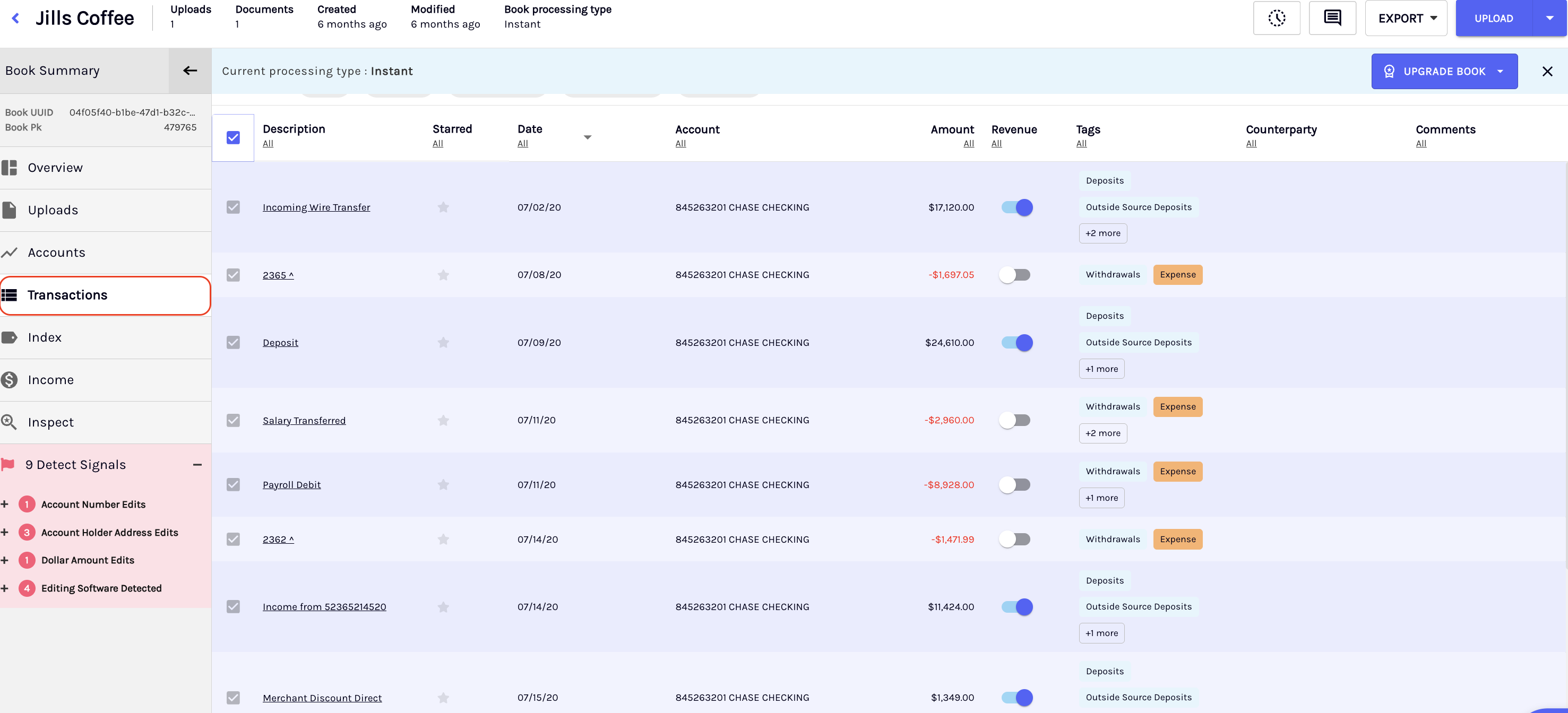
The table below outlines the available fields in the Transactions table, along with their corresponding descriptions:
| Field | Description |
|---|---|
| Description | A brief description of the transaction. |
| Starred | A transaction that is marked for future reference. |
| Date | Date of the transaction. |
| Account | The account in which the transaction occurred. |
| Amount | Amount of the transaction. |
| Revenue | This setting determines whether a transaction will be included in the calculation of income/revenue. The transaction is included when toggled ON (blue and to the right). When toggled OFF (gray and to the left), the transaction is excluded. Any updates made here will be reflected in the Accounts page in addition to any data that is exported. |
| Tags | Transaction tags that are generated by our proprietary enriched transactions algorithm. To know more about transaction tags and their definitions, see Ocrolus analytics data dictionary. |
| Counterparty | When it is available, the counterparty is involved in the transaction. |
| Comments | Space to allow a comment added by a member of the organization |
Each column on the Transactions page is also filterable by clicking on All underneath the column headers and selecting your desired values.
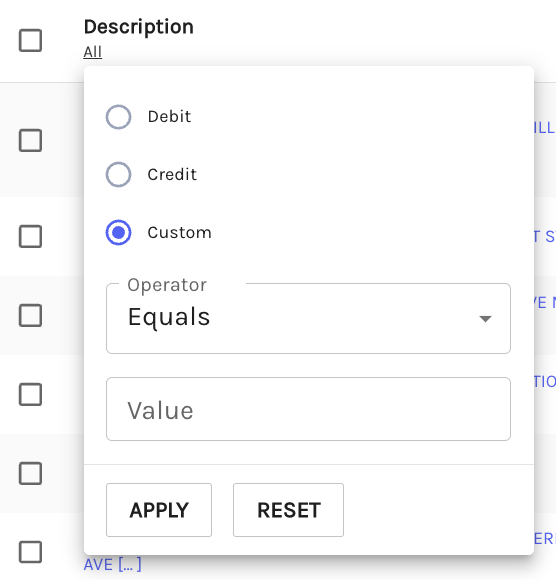
Certain columns are sortable by clicking on the “^” next to the column header. Columns that are currently sortable are Date and Amount.
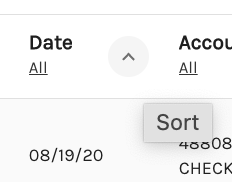
Searching, filtering, and sorting transactions
The Transactions page allows you to search for transactions or keywords using the search bar, with results filtering automatically as you type. Additionally, you can filter by date, tags, or specific column values, and sort by date or amount for a more refined view.
Searching transactions
You can search for transactions or keywords using the search bar at the top of the Transactions page. As you type, the table will automatically filter and auto-suggest the transactions to match the entered text.

Applying date range
You can use the DATE filters next to the search bar to include transactions based on the specific date range.
To apply the date range, perform the following steps:
-
Click on the DATE option.

-
Choose the appropriate Operator from the dropdown list. Depending on the selected Operator, the subsequent options will change. The available Operators include:
-
Between: Select this option to include transactions that occurred within a specific date range. When selected, the Select Start Date and Select End Date fields will appear. Enter the start and end dates, and the system will calculate only the transactions that fall within the specified range.
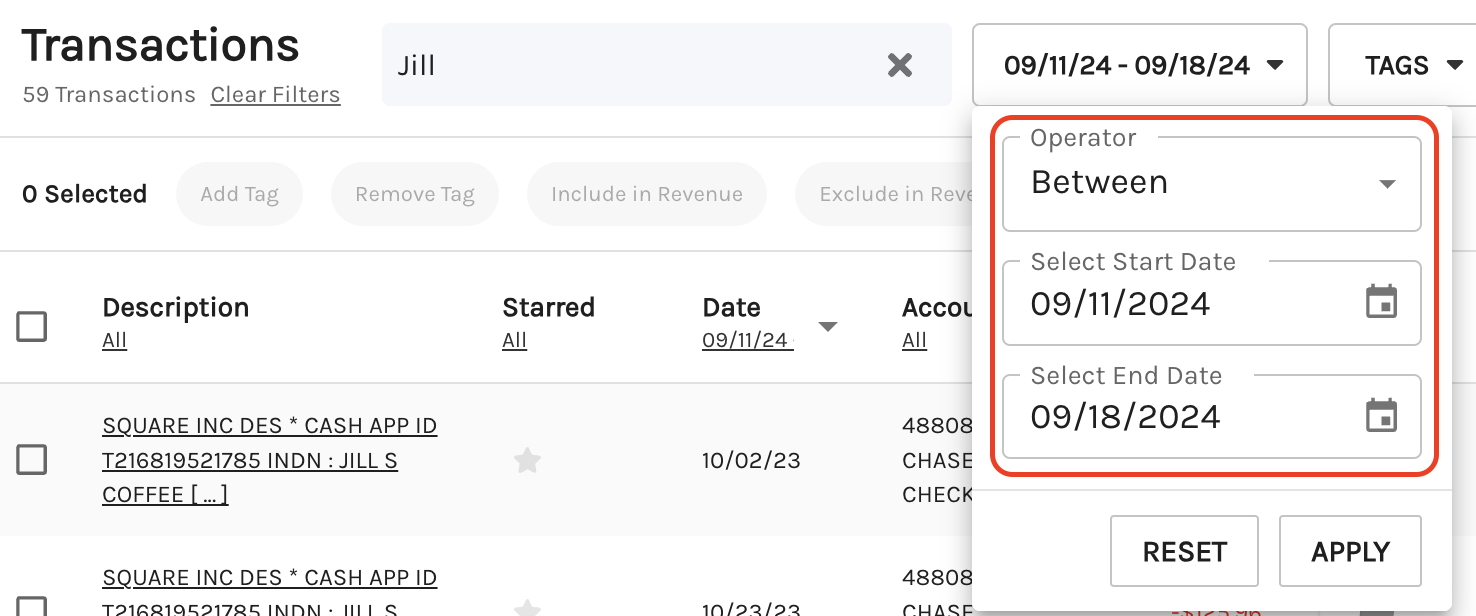
-
Equals: Select this option to include transactions that occurred on a specific date. When selected, enter the desired date.
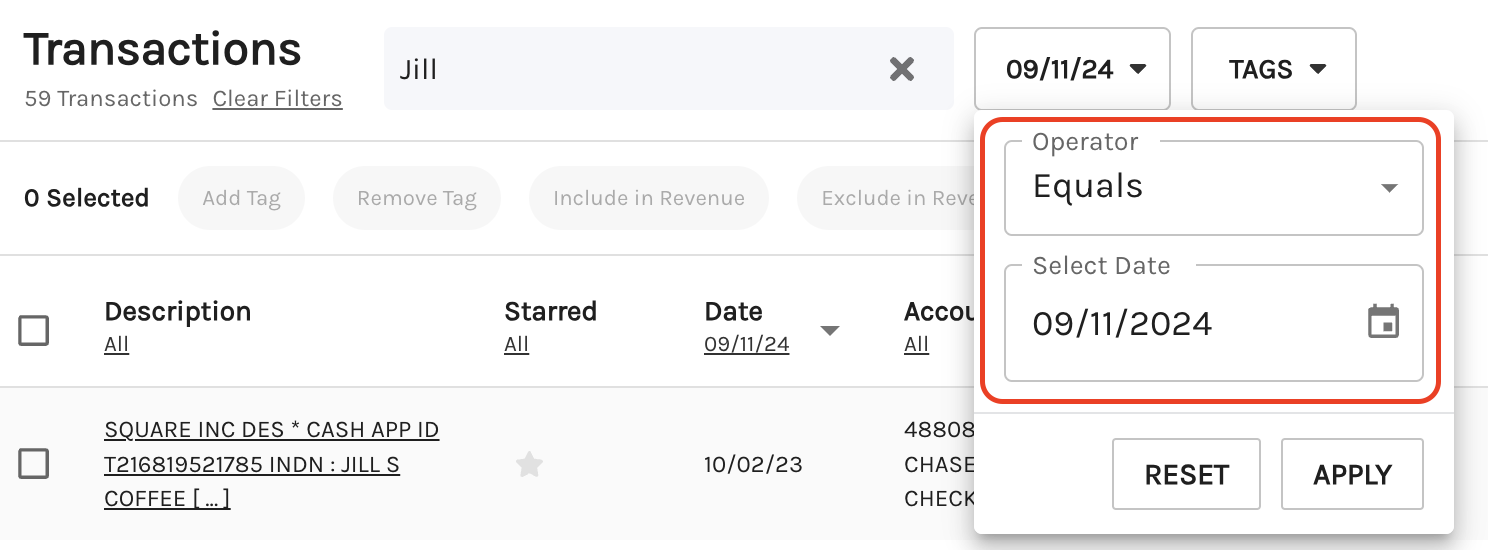
-
-
Click on the APPLY button.
Applying tags
You can use the TAGS to include and exclude certain types of transactions.
To add/remove tags, perform the following steps:
-
Click on the TAGS option.
-
Choose the appropriate option from the dropdown list. The available options include:
-
Match all: Select the required tag(s). The system will include a transaction only if it meets all the selected criteria.
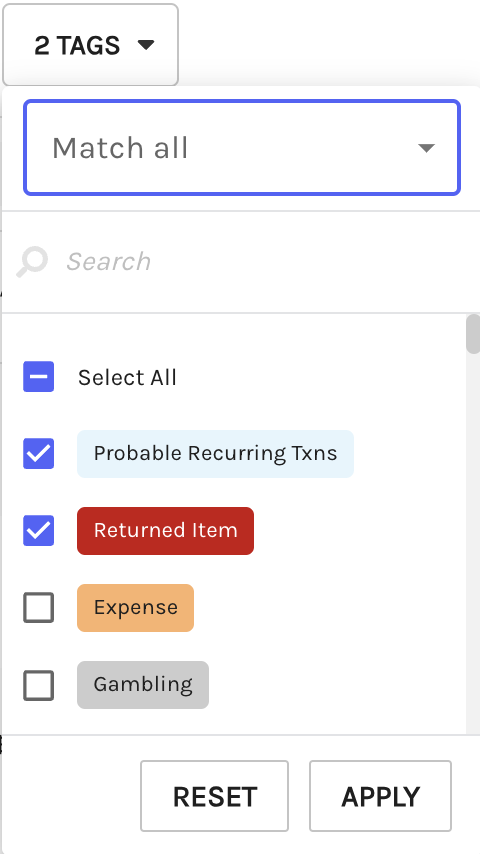
-
Match any: Select the required tag(s). The system will include a transaction if it meets at least one of the selected criteria. This means that if a transaction satisfies any of the conditions, it will be included.
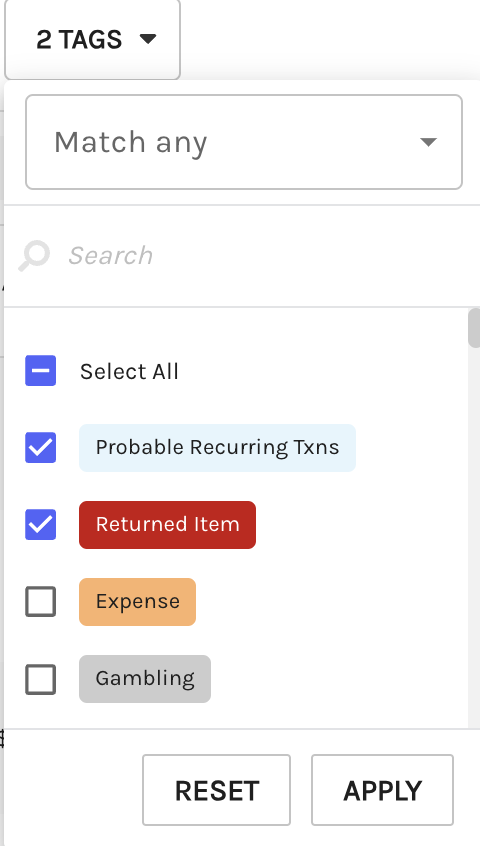
-
-
Click on the APPLY button.
Viewing transaction details
You can click on a specific transaction to view detailed information about that transaction in the Capture Details panel that appears on the right side of the screen. This panel provides key information, including the transaction description, editable transaction tags, and editable revenue calculation status.
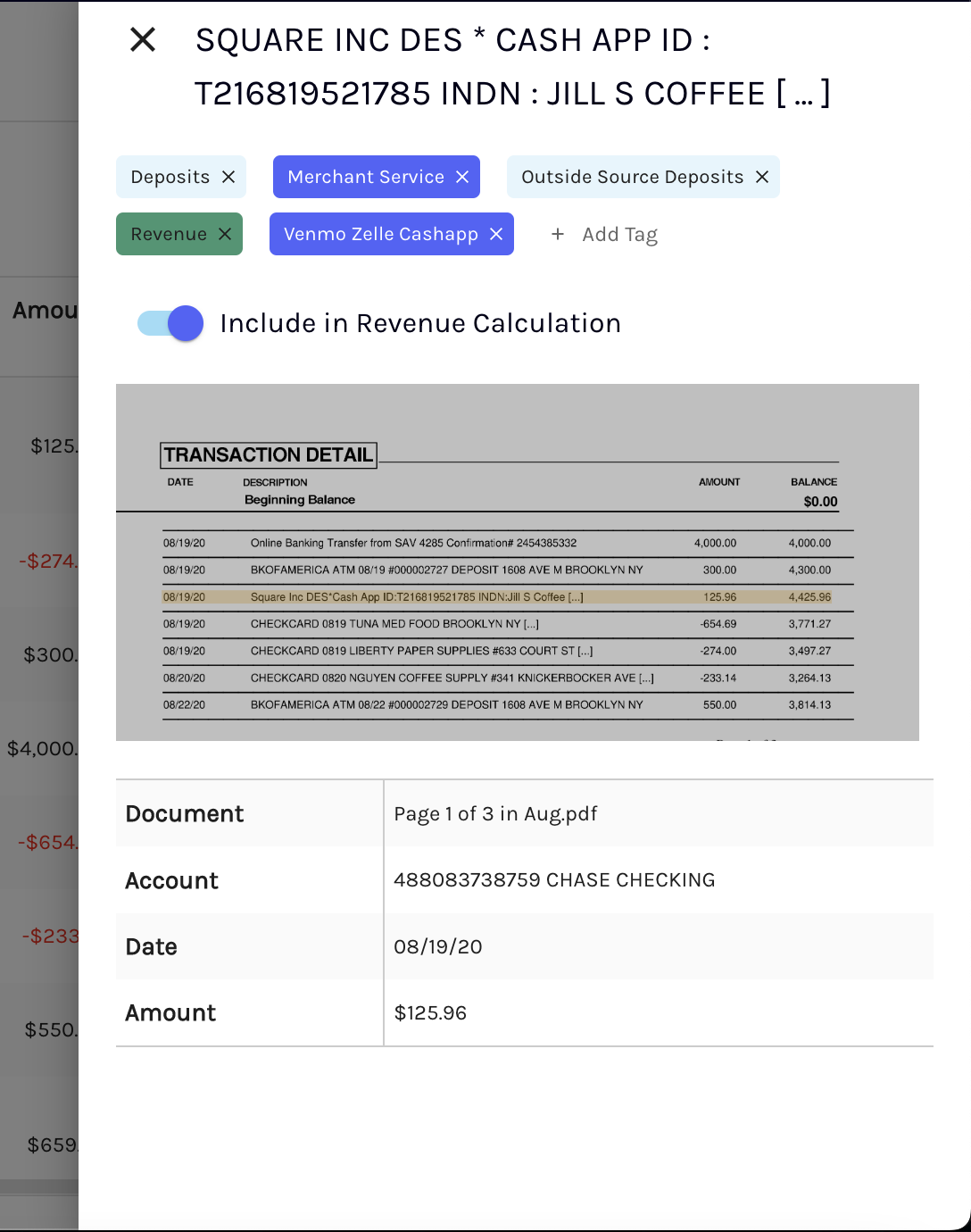
Additionally, it displays capture details and an image of the original document where the transaction occurred, with the transaction highlighted in yellow.
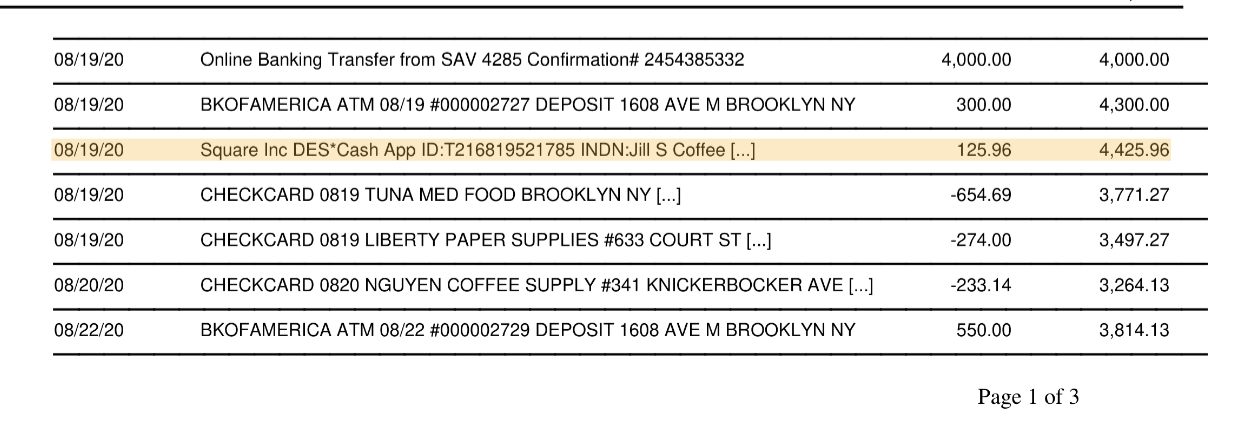
Updating transaction details
Ocrolus’ proprietary transaction tagging algorithm is designed specifically for lenders and is based on a vast number of data points received daily. However, there may be instances where you want to adjust how a transaction is tagged. In such cases, you can modify the tags by:
-
Using the Tags column to select or deselect the desired tags
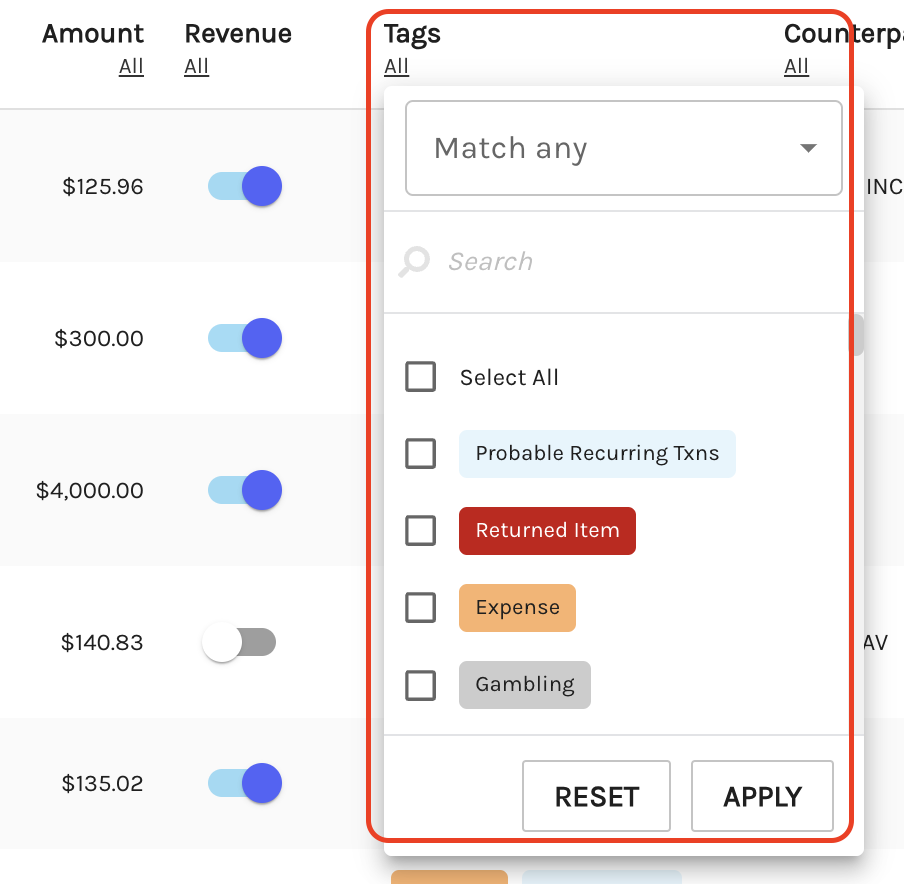
-
Making changes in the Capture Details panel as described earlier
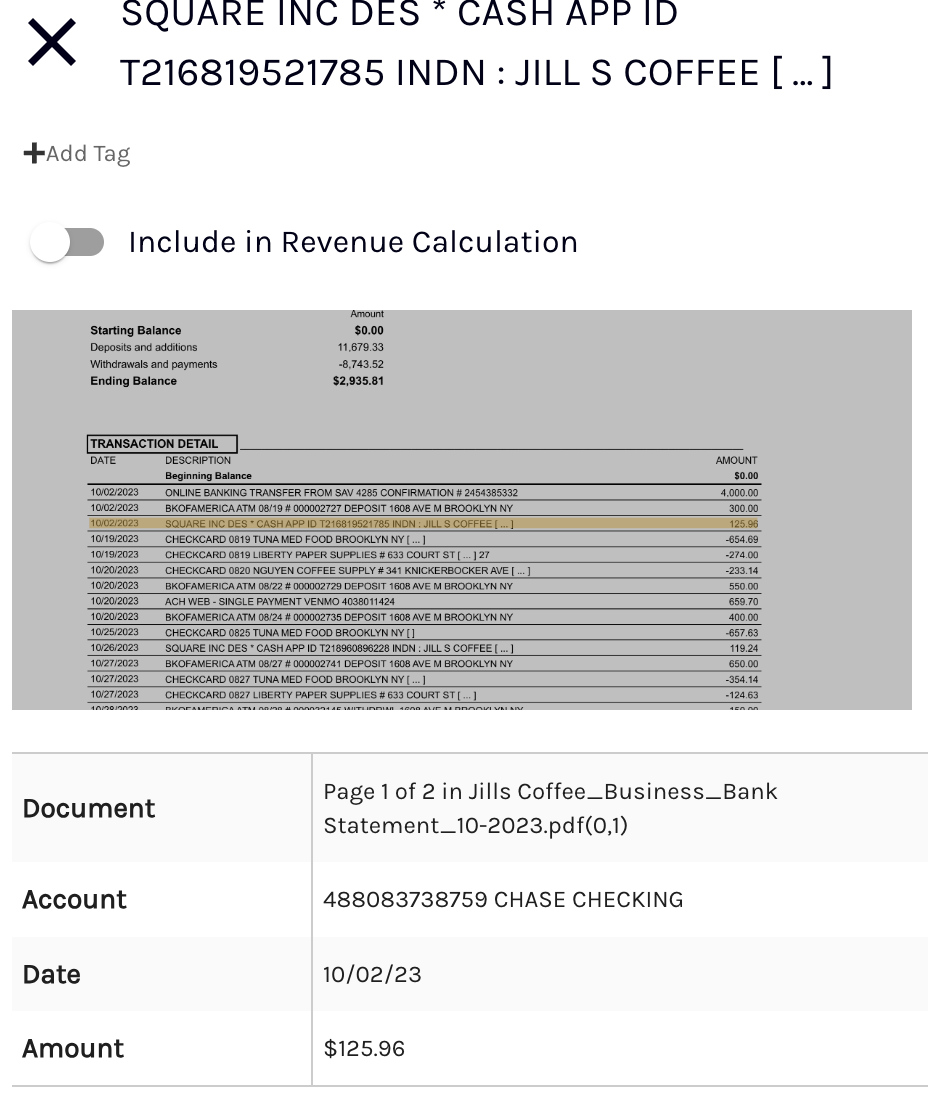
-
Utilizing the Bulk Action feature to update multiple tags at once
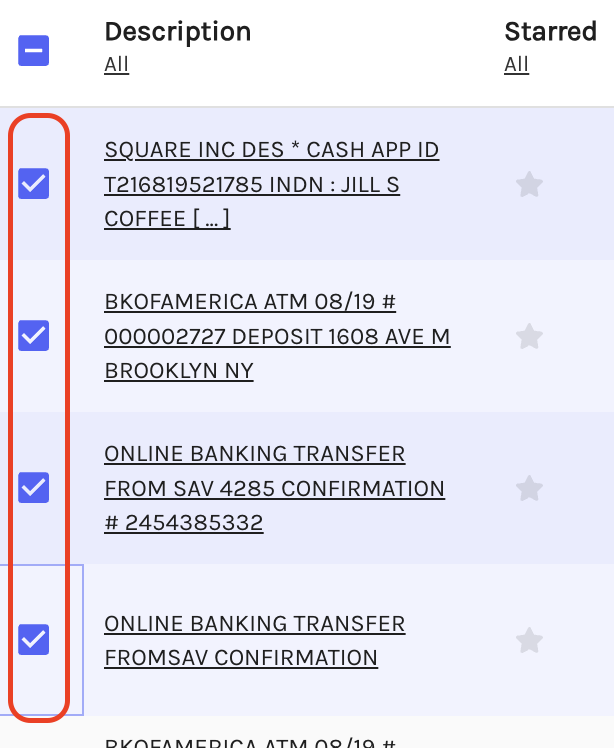
Updating transactions in bulk
To update multiple transactions at once, select the transactions by clicking the box on the left side of the Transactions screen. After selecting, the following actions will appear at the top of the page:
- Add tag: Adds tags to all selected transactions.
- Remove tag: Removes tags from all selected transactions.
- Include in revenue: Includes the selected transactions in income/revenue calculations. Updates made here will be reflected on the Accounts page and in any exported data.
- Exclude in revenue: Excludes the selected transactions from income/revenue calculations. Updates made here will be reflected on the Accounts page and in any exported data.
- Export Selected: Exports details of the selected transactions in .xlsx format.
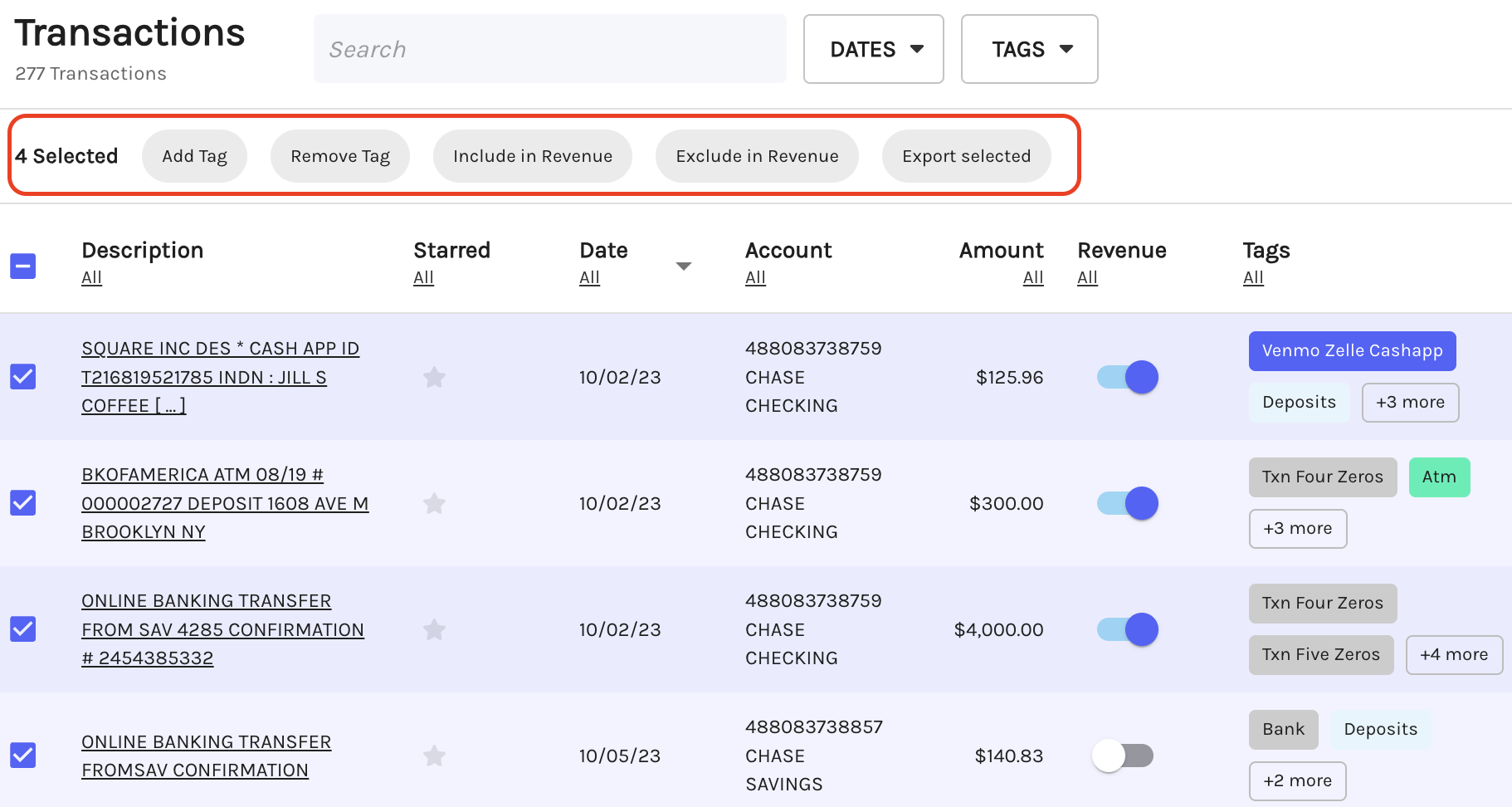
Create transaction tags
This feature allows you to enhance transaction tagging by creating and applying tags based on specific criteria, including exact include/exclude terms and optional amount thresholds. It offers flexibility, with immediate updates reflected in transactions and analytics.
To create or update transaction tagging, perform the following steps:
-
Upon login to the Ocrolus Dashboard, click on the profile icon and select Tag Management from the dropdown list.
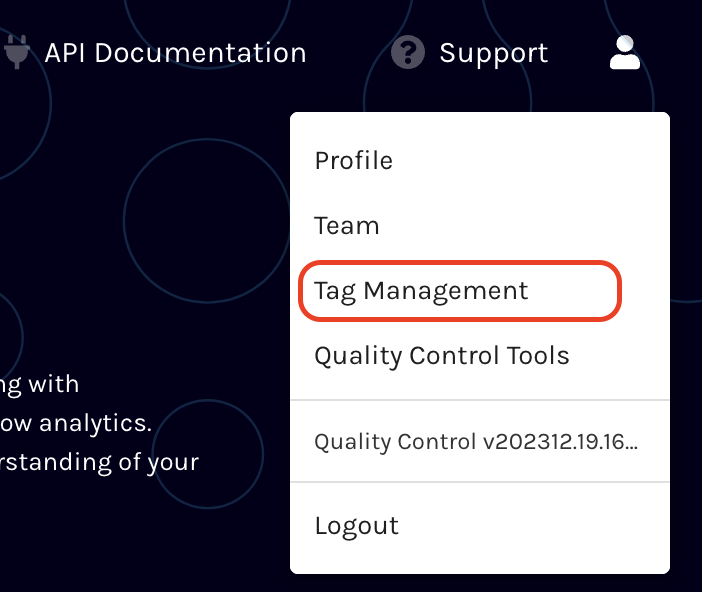
-
On the Tag Management page, all the existing custom tags are listed.
Note:
To manage existing custom tags, click on the vertical ellipsis icon and edit or delete the intended created custom tags.

-
Click on the ADD TAG button to create the new custom tag.

-
On the Add custom tag tag pop-up page, enter the following details:
-
Tag label: Enter a name for the custom tag.
-
Description: Optionally, add a description for better context.
-
Color: Choose a color to distinguish the tag visually.
-
Exact Include Terms (Required): Specify terms for precise tag application.
-
Exact Exclude Terms: If applicable, define terms for exclusion.
-
With amounts: Set the amount or amount range thresholds, if needed.
-
With recurrence: Set the recurrence frequency as desired.
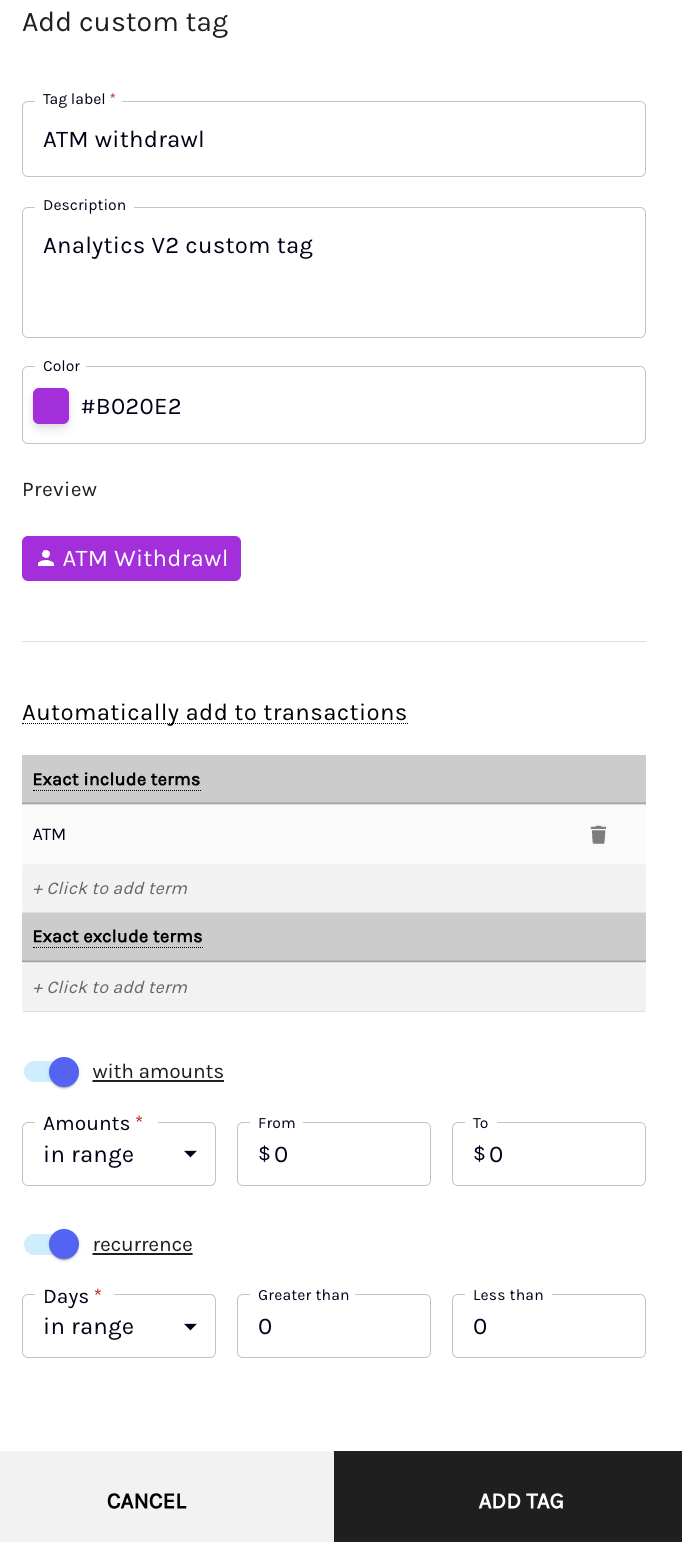
-
-
Click on the ADD TAG button.
-
Once a custom tag is created, it will automatically be applied to all relevant transactions. You can view these tagged transactions on the Transactions page.
Modify system transaction tags
Ocrolus also includes ready-to-use System Tag categories specifically designed for lending scenarios.
To use the system tags, perform the following steps:
-
Upon login to the Ocrolus Dashboard, navigate to the profile icon and select Tag Management from the dropdown list.

-
On the Tag Management page, select the System Tag that you want to customize and then click Edit.

-
On the Edit System Tag pop-up page, enter the following details:
- Exact include terms: Terms for precise tag application. This is a mandatory field.
- Exact exclude terms: The terms that need to be excluded. This is an optional step.
- With amounts: Set the amount or amount range thresholds, if needed.
- With recurrence: Set the recurrence frequency as desired.

-
Click on the UPDATE TAG button.
-
Once a system tag is updated, it will automatically be applied to all relevant transactions. You can view these tagged transactions on the Transactions page.
Updated 6 months ago